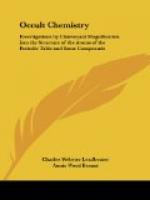the two pairs becoming 2 quartets; the connecting rod exactly reproduces
the rods of chlorine and bromine; the funnel is also that of bromine,
except that five bodies, containing 35 atoms, are added to it. The 1439
atoms of bromine are thus raised to 2887.
IODINE: Upper Part {12 funnels of 90 atoms
1116
{Central
globe 18
Lower
part same 1134
Connecting
rod 19
——
Total
2287
——
Atomic
weight 126.01
Number
weight 2287/18 127.055
The plan underlying the building up of groups is here
clearly shown; a
figure is built up on a certain plan, in this case
a dumb-bell; in the
succeeding members of the group additional atoms are
symmetrically
introduced, modifying the appearance, but following
the general idea; in
this case the connecting rod remains unaltered, while
the two ends become
larger and larger, more and more overshadowing it,
and causing it to become
shorter and thicker. Thus a group is gradually
formed by additional
symmetrical additions. In the undiscovered remaining
member of the group we
may suppose that the rod will have become still more
egg-like, as in the
case of gold.
I b.—The corresponding positive group to that which we have been considering consists of Na, Cu, Ag, and Au (sodium, copper, silver and gold), with an empty disk between silver and gold, showing where an element ought to be. These four elements are monads, diamagnetic, and positive, and they show the dumb-bell arrangement, although it is much modified in gold; we may presume that the undiscovered element between silver and gold would form a link between them.
[Illustration: PLATE VI.]
SODIUM (Plate VI, 2) has been already described (p. 349, January), as a type of the group, so we need only refer to its internal arrangement in order to note that it is the simplest of the dumb-bell group. Its twelve funnels show only four enclosed bodies, the same as we see in chlorine, bromine, iodine, copper and silver, and which is very little modified in gold. Its central globe is the simplest of all, as is its connecting rod. We may therefore take it that sodium is the ground-plan of the whole group.
SODIUM: Upper part
{
12 funnels of 16 each 192
{
Central globe 10
Lower
part same 202
Connecting
rod 14
——
Total
418
——
Atomic
weight 23.88




